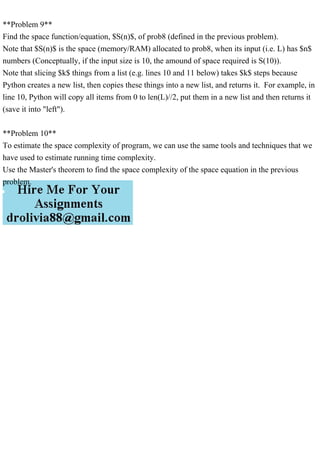Problem 9Find the space functionequation, $S(n)$, of prob8 (d.pdf
**Problem 9** Find the space function/equation, $S(n)$, of prob8 (defined in the previous problem). Note that $S(n)$ is the space (memory/RAM) allocated to prob8, when its input (i.e. L) has $n$ numbers (Conceptually, if the input size is 10, the amound of space required is S(10)). Note that slicing $k$ things from a list (e.g. lines 10 and 11 below) takes $k$ steps because Python creates a new list, then copies these things into a new list, and returns it. For example, in line 10, Python will copy all items from 0 to len(L)//2, put them in a new list and then returns it (save it into "left"). **Problem 10** To estimate the space complexity of program, we can use the same tools and techniques that we have used to estimate running time complexity. Use the Master's theorem to find the space complexity of the space equation in the previous problem..

Recomendados
Más contenido relacionado
Similar a Problem 9Find the space functionequation, $S(n)$, of prob8 (d.pdf
Similar a Problem 9Find the space functionequation, $S(n)$, of prob8 (d.pdf (20)
Más de kishorchelani123
Más de kishorchelani123 (20)
Último
Último (20)
Problem 9Find the space functionequation, $S(n)$, of prob8 (d.pdf
- 1. **Problem 9** Find the space function/equation, $S(n)$, of prob8 (defined in the previous problem). Note that $S(n)$ is the space (memory/RAM) allocated to prob8, when its input (i.e. L) has $n$ numbers (Conceptually, if the input size is 10, the amound of space required is S(10)). Note that slicing $k$ things from a list (e.g. lines 10 and 11 below) takes $k$ steps because Python creates a new list, then copies these things into a new list, and returns it. For example, in line 10, Python will copy all items from 0 to len(L)//2, put them in a new list and then returns it (save it into "left"). **Problem 10** To estimate the space complexity of program, we can use the same tools and techniques that we have used to estimate running time complexity. Use the Master's theorem to find the space complexity of the space equation in the previous problem.